Battle for the Caucasus: no invasions from land
Before the start of the Great Patriotic War, two military districts were located on the territory of the North Caucasus and Transcaucasia - the North Caucasus and the Transcaucasian. Since 1939, the formation of rifle and cavalry divisions begins in the North Caucasus Military District, tank brigades, artillery units and aviation divisions, of which the 1941th Army was created in May 19. The commander of this army was Lieutenant General I.S.Konev, who had previously commanded the troops of the North Caucasus Military District. From the first days of the Great Patriotic War, the 56th Separate Army was formed on the territory of the North Caucasian Military District, led by the commander of the North Caucasian Military District, Lieutenant General FN Remezov. This army had the task of covering Rostov from the west and northwest. On the territory of the North Caucasian Military District, the 57th Reserve Army was also formed under the command of Lieutenant General D.I. Ryabyshev. The 9th Army of Major General F.M. Kharitonov fought as part of the Southern Front.
In the Transcaucasus, troops of the Transcaucasian Front were stationed under the command of Lieutenant General D.T. Kozlov (until December 1941). The troops of the Transcaucasian Front were entrusted with the defense of the southern part of the Black Sea coast. The main forces of the front were concentrated on the Soviet-Turkish border because of the clearly pro-German policy of Turkey. Part of the forces of the front 25 August 1941 was introduced into Iran in accordance with the Soviet-Iranian agreement and the agreement with England. Therefore, the Supreme Command did not have the ability in the first period of the war to fully use the troops of the Transcaucasian Front to strengthen the defense of the Caucasus from the north.
The Soviet Union also had a military fleet in the Black Sea, it was the strongest among the Navy of the Black Sea states. The forces of the Novorossiysk and Batumi naval bases were located in the Caucasus. A month after the outbreak of war, the Poti Naval Base was formed. In collaboration with the troops of the Transcaucasian Military District, parts of the Poti Naval Base defended the Black Sea coast from the state border with Turkey to Adler. The forces of the Novorossiysk Naval Base, which then also included the Kerch fortified sector of coastal defense, in cooperation with the troops of the North Caucasus Military District, defended the Caucasus coast from Adler to the Kerch Strait. To strengthen the defense of the Azov coast, by the order of the People's Commissar of the Navy of July 23, 1941, formation began as part of the Black Sea fleet Azov military flotilla. It included several gunboats, patrol boats and minesweepers. Mostly from converted civilian vessels.
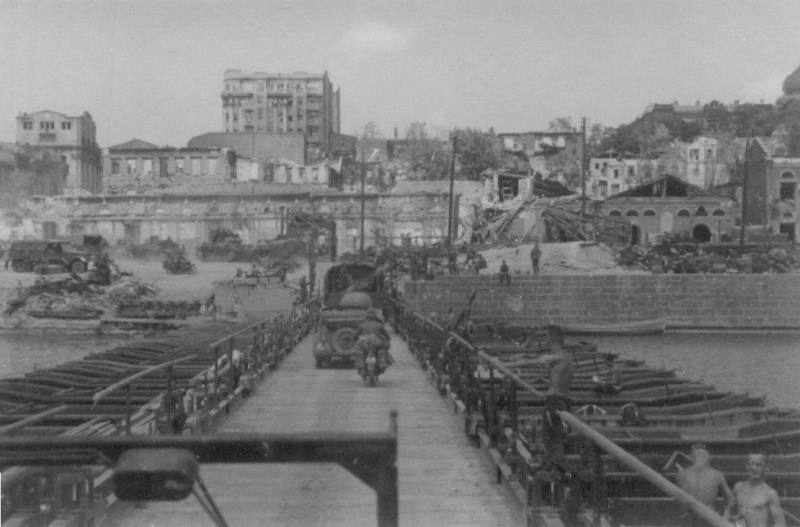
Crossing the Don in the center of the occupied Rostov-on-Don. July 1942 of the year. Photo source: http://waralbum.ru/
Before the beginning and during the Great Patriotic War, the air forces of the North Caucasus and Transcaucasian military districts actively developed: on the territory of the North Caucasus Military District are created aviation brigades, Bataysk, Yeysk, Taganrog schools of military pilots; there was a large construction of new and reconstruction of the existing airfields. Two air armies were created on the territory of the North Caucasus: the 4-I Army, Major General KA Vershinin, and 5-I, the Army Lieutenant General S. K. Goryunov. By the beginning of the battle in General Vershinin's 4 Air Army, 130 remained serviceable aircraft, in the General Army Goryunov's 5 Air Force - 135, in the Black Sea Fleet Air Force there were 216 machines. By the beginning of the battle for the Caucasus in the units and formations of the Trans-Caucasian Front air forces there was up to 409 combat aircraft. In addition, there were about 8 aircraft in the air regiments and 800 aviation schools (including 125 fighters, 107 bombers, and 568 training aircraft). Subsequently, during the hostilities in the North Caucasus, on instructions from the Supreme Command, the 44 Army formed 4 Fighter Aviation Regiments (72 aircraft) from the aviation of the Transcaucasian Front, which had to support the 44 Army in defending the approaches from the North Caucasus Makhachkala and Baku. The rest of the aviation forces (Air Force 45, 46 Army and Air Force of the Transcaucasian Front) were intended to defend the borders with Turkey and Iran.
The significant removal of the Caucasus from the western borders of the USSR suggested that there would be no invasion of the enemy from the land. At the beginning of the war, few could have imagined that the Wehrmacht would reach the Don and the Volga. Mainly feared sea and airborne assault. Therefore, the defense of the Caucasus from the north, that is, from the Don, was given little attention. Only in the Baku direction on the river. Sulak was located two divisions of the 44 Army of the Transcaucasian Front, covering Baku from the north and north-west, and along the r. Terek passed defensive line, erected in winter 1941 g. Most of this milestone in the spring 1942 g. Was destroyed by flood. Air defense was weakly organized on the territory of the North Caucasus. The main attention in preparing the defense was given to the Black Sea coast. The defense of the Black Sea coast and naval bases began to be created even before the start of the war. However, there were problems. So, it was built on the principle of repelling the attack of enemy forces mainly from the sea and air. With the organization of land defense, the situation was bad. There were no attacks from the land side, so the construction of defense lines, strongholds and fortifications to repel a possible attack by the fleet base from the land direction was not carried out. The need to create such a defense system came as a surprise to our command. Only with the beginning of the war began to strengthen the defense of the coast: the formation of new coastal units and artillery batteries, the deployment of new naval bases and the construction of fortified areas around them, as well as strongholds on the coast between the bases began. As a rule, three defensive lines were created around each base: forward, main and rear. The defense of the coast was built in the form of separate units of resistance, created in the most probable landings of enemy landings and included two or three lines of artillery, mortar and machine-gun pillboxes and bunkers, trenches, trenches, wire and minefields. From the sea, these areas were covered with minefields and ship patrols. Thus, the formation of a unified coastal defense system from the sea, land and air began. The coast of the Azov and Caspian seas was strengthened in the same way, but much later - in the spring and summer of the 1942 year.
During the war, the development of naval defense continued. In August - November 1941, the forces and facilities of the Novorossiysk base formed the Kerch and Tuapse naval bases. On the Azov Sea, Mariupol (the main base) and Rostov-on-Don became the first bases of the flotilla. But soon they were under the threat of attacking enemy forces. Therefore, equipment and adaptation to the base of the military forces of the commercial and fishing ports of Yeisk, Primorsko-Akhtarskaya and Temryuk began, where regular naval bases were deployed during the first year of the war.
The closer the front approached the Caucasus, the higher the probability of the German army breaking into the region from the north. By order of the Commander of the North Caucasus Military District of 3 on April 1942, the entire territory of the district was divided into 11 combat areas: 1 with the center in Salsk, 2 with Krasnodar, 3 with Voroshilovsk, 4 with Armavir, 5 with th - Cherkessk, 6-th - Pyatigorsk, 7-th - Nalchik, 8-th - Budyonnovsk, 9-th - Mozdok, 10-th - Ordzhonikidze, 11-th - Grozny. The defense of each of these sites was assigned to the appropriate formations, units and military educational institutions located within the borders of the sites. However, a big problem was the lack weapons, equipment, ammunition, material base in general.
4 in May 1942, the SKVO headquarters, with combat orders on measures to organize the protection of the most important objects from airborne assault forces and enemy sabotage groups, demanded that all important objects (bridges, tunnels, passes, water sources, etc.) be taken into account and protected. Fighter battalions were also established on the territory of the North Caucasian Military District at the regional centers and points important militarily. Formed detachments of the national militia, partisan detachments. The Don Cossack Division was established on the territory of the Rostov Region. In particular, units of the Rostov regiment of the national militia showed exceptionally high fighting qualities in the battles for their hometown. “Everything is for the front, everything is for victory” - under this slogan was the mobilization of the population of the Caucasus.
During the fierce battles in the Crimea, when the threat of German troops breaking through to the Caucasus was growing, the Supreme Command Headquarters 21 of April formed the North Caucasus direction. The North Caucasus direction included: the Crimean Front, the Sevastopol Defense Area (SOR), the Black Sea Fleet with the Kerch, Novorossiysk and Tuapse naval bases, the Azov Flotilla, and the North Caucasus Military District. With the loss of the Crimea, there was an immediate threat to the Caucasus. 19 May 1942. By decision of the Headquarters, the Crimean Front was disbanded, and the North Caucasus sector was reorganized into the North Caucasus Front. The commander of the front was appointed Marshal of the Soviet Union S. M. Budyonny. The front included troops of the former Crimean Front, formations and units located on the shores of the Azov and Black Seas. The Black Sea Fleet, the Azov Military Flotilla and the North Caucasus Military District were subordinate to the front commander.
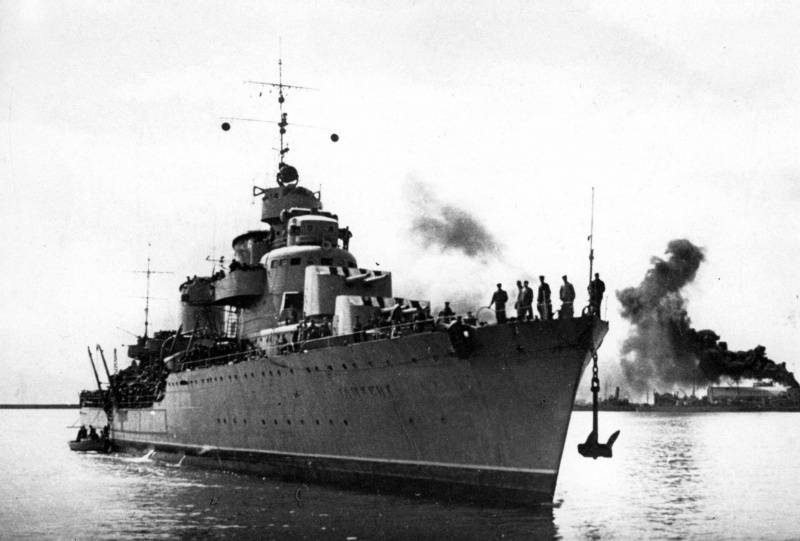
The leader of the destroyers "Tashkent" in the harbor
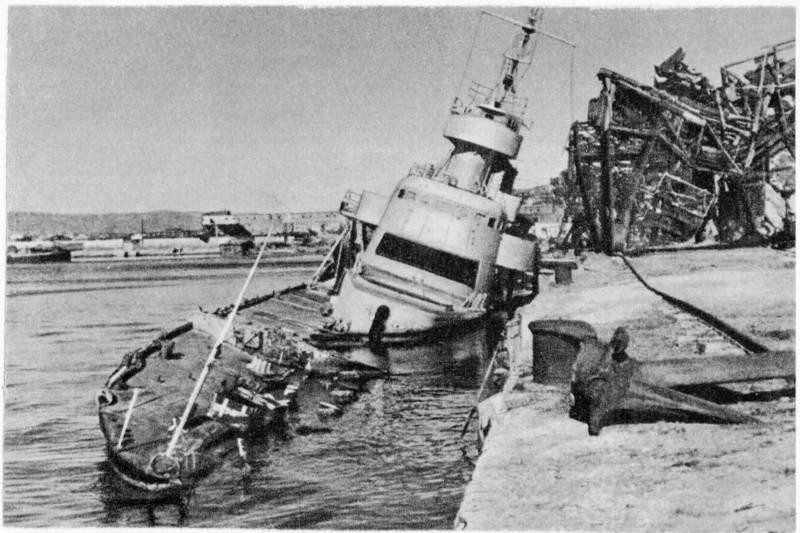
The submerged leader of the destroyers "Tashkent". The ship was sunk by German aircraft in the port of Novorossiysk 2 July 1942
The position of the Soviet troops to the beginning of the battle
The German Army Group "A" was opposed by the troops of the Southern and part of the forces of the North Caucasus Front. The troops of the Southern Front under the command of Lieutenant-General R. Ya. Malinovsky defended themselves on the left bank of the Don from Verkhne-Kurmoyarskaya to the mouth of the river. The Southern Front was faced with the task of eliminating the enemy that had broken through to the left bank of the Don River and, having restored the situation, firmly hold the occupied lines. The total width of the defense line was 320 km. The front had 7 armies: 9-I Army, 12-I Army, 18-I Army, 24-I Army, 37-I Army, 51-I Army and 56-I Army. Air support was provided by the 4-I air army. July 28 The 1942 Front was merged with the North Caucasus Front, the 51 Army transferred to the Stalingrad Front.
At first glance, the troops were many. But these were already defeated army, with huge losses in manpower and equipment. On the right wing of the front from Verkhne-Kurmoyarskaya to Konstantinovskaya in the 171 km-wide strip, the 51-i army, commanded by Major General T.K. Kolomiets, defended itself. This army fought with enemy groups that captured small bridgeheads on the left bank of the Don River in the Tsimlyansk and Nikolaev regions. The army had 4 rifle and 1 cavalry divisions, all 40 thousand people. The 37-I Army, who had left for Don, Major-General P. M. Kozlov, was holding up the defensive along the southern bank of the Don from Konstantinovskaya to Bogayevskaya, in a strip up to 65 km wide. The army numbered about 17 thousand people. The 12 Army under the command of Major General A. A. Grechko in the 3 rifle divisions, having about 17 thousand people, defended themselves at the front width of 40 km, from Belyanin to Kiziterinka. The 18 Army I, Lieutenant General FV Kamkov, as part of the 3 rifle divisions and the 1 rifle brigade, which numbered about 20 thousand, held defenses on a front about 50 km wide, from Kyzyterinka to the mouth of the Don. The 56 Army I, commanded by Major General A. I. Ryzhov, had 5 rifle divisions and 3 rifle brigades, totaling about 18 thousand people. This army, after heavy defensive battles in Rostov, was withdrawn to the second echelon. Major-General V.A. Parkhomenko, who had the remnants of 24 rifle divisions, could not take part in the battles for the 9-th Army, Major-General F.A. Parkhomenko, who had remnants of 11 rifle divisions. Wed Egorlyk to replenish and restore. The reserve of the front was small — the rifle and cavalry divisions concentrated in the zone of the 37 Army.
Thus, on the front in 320 km only 5 of small armies of the Southern front defended, in which there were only about 112 thousand people, 121 tank, 2160 guns and mortars. These were serious forces (taking into account the advancing reserves), if the command had managed to organize the defense. However, the troops were again stretched into a line without second echelons and reserves. The artillery reinforcement of the troops of the Southern Front was very weak. The 17 artillery regiments in its composition could not be used effectively due to a serious shortage of ammunition. Due to the limited number of crossings, the artillery units withdrew from their troops on the left bank of the Don, and in the 37 Army the artillery regiments lost all their material equipment in the battles during the withdrawal of the Don. 4-I air army could not provide a full cover from the air. In addition, due to the rapid retreat, the situation with the logistics of the troops was unsatisfactory. A hasty retreat required the urgent evacuation of wealth from areas threatened by occupation. Railroad tracks were clogged with trains. On dirt roads from the Don to the Kuban, a huge amount of motor and horse-drawn vehicles, refugees and livestock moved. This greatly complicated the normal supply of Soviet troops, in which there was an acute shortage of ammunition and fuel.
The North Caucasian Front at that time held defenses from the mouth of the Don along the eastern shore of the Azov Sea, the Kerch Strait and along the Black Sea coast to Lazarevskaya. The front line consisted of the 47 Army, the 1 Army Corps and the 17 Cuban Cavalry Corps and the 5 Air Army. Kavkorpus was a volunteer formation, it was based on the Cossacks of non-conscript age, that is, older than 50 years. The front troops, which consisted of more than 200 thousand soldiers, were ordered to defend the east coast of the Azov Sea and the Taman Peninsula and to prevent the enemy from forcing the Kerch Strait. The Black Sea Fleet and the Azov Military Flotilla were tasked to support ground forces and prevent the landing of naval landings of the enemy. The fleet allocated thousands of marines and coast guards for ground operations 87. The troops of the Transcaucasian Front under the command of General of the Army I. V. Tyulenev (44 Army, 45 Army, 46 Army and 15 Cavalry Corps) defended the Black Sea coast from Lazarevskaya to Batumi and further along the Soviet-Turkish border. Part of the forces of the front, according to the agreement, was in northern Iran, covering the Iranian-Turkish border.
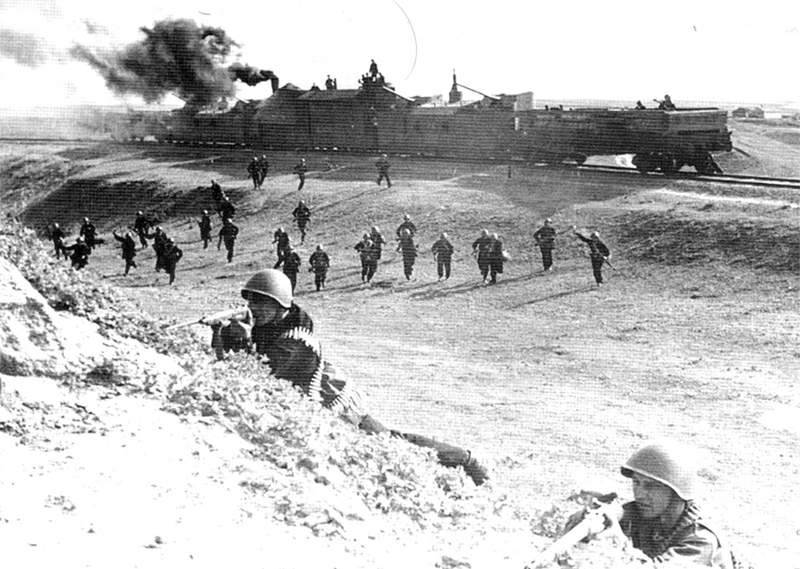
The armored train of the Azov flotilla "For the Motherland" with 76-mm universal naval guns. North Caucasus Front, August 1942
The defense of the Caucasus from the north was still poorly prepared for the start of hostilities. The Military Council of the North Caucasian Military District still 16 June 1942 decided to create defensive lines between the Don and the Kuban, on the Terek, on the Taman Peninsula, along the coast of the Azov and Black Seas of the total length (including Tikhoretsky, Voroshilovsky, Grozny and Mineralvodsky lines) 2050 km. It was planned to build 580 battalion areas and 10 company areas in all defensive lines. However, by the beginning of the hostilities, the entire 180 battalion area and the company 1 had been completed. The serious shortcomings of the defensive line were their weak anti-tank defense and the almost complete absence of camouflage. Before defensive lines at the front in 1950 km, it was planned to create several obstacle lanes to a depth of 100 km. First of all, it was supposed to prepare anti-tank and anti-personnel barriers in the most probable directions of enemy actions.
According to the memoirs of Marshal A.A. Grechko: “The commander of the armies and the commanders of the Separate rifle and 17 cavalry corps were ordered to prepare all the structures on the roads for the explosion, many sections of the road bed, to set up minefields, to prepare areas for flooding and waterlogging, to destroy the military objects and railway junctions; in front of the front edge of the main defensive line and rear defensive lines to create solid strips of all types of obstacles 6-8 km deep, leaving in them passages prepared for the barrier for their troops. However, all these plans for the most part were not fulfilled ”(A. A. Grechko, A. A. Battle of the Caucasus. M., 1967.).
On July 19, the General Staff sent a telegram to Marshal Budyonny: “According to the General Staff, the fortifications and the organization of work to strengthen the Azov, Black Sea coasts and the south bank. Don have a number of significant shortcomings, and the command of some parts and formations of the front criminal negligently refers to the organization of the defense of the areas they occupy. So, for example, the 113 defense sector of the Sbr over two months was checked by nine commissions and everyone noted the same flaws. This situation also testifies to the lack of proper leadership in the defense work of the front headquarters. ” On the whole, the armies of the Southern Front did not have time to prepare for defense. More or less entrenched only 51-I army.
At the same time, the troops of the Transcaucasian Front began to prepare for defense. The 46 Army was ordered: continuing to carry out the tasks of defending the Black Sea coast and the Soviet-Turkish border, using 392 and 389 rifle divisions and 3 rifle corps to cover the roads and passes leading from the north through the Main Caucasus Range, and Do not allow the enemy to the coast of the Black Sea and the valley. Rion. On June 23, the commander of the Transcaucasian Front ordered the 417 Infantry Division to prepare a defensive line at the Cross Pass and organize defense in the Kazbegi region, Guda-Makarsky Pass. The next day, June 24, the Commander-in-Chief of the Zakfront ordered the 44 Army Commander to prepare for the July 30 a strip of obstacles between the Terek and Sulak rivers from the Caspian Sea to the right and left along the Grozny to Botlikh highway with the Terek leading edge. It was ordered to prepare for 30 August also rear defensive lines: Derbent gate and on the line r. Samur. Baku was also preparing for the defense.
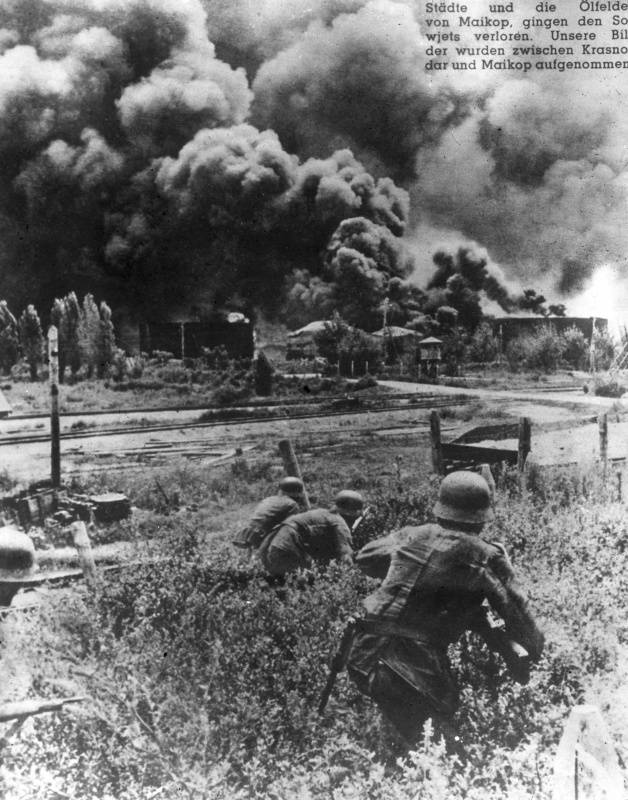
In the area of Maykop and Krasnodar. German soldiers approaching the oil storage, set on fire by the retreating units of the Red Army
To be continued ...
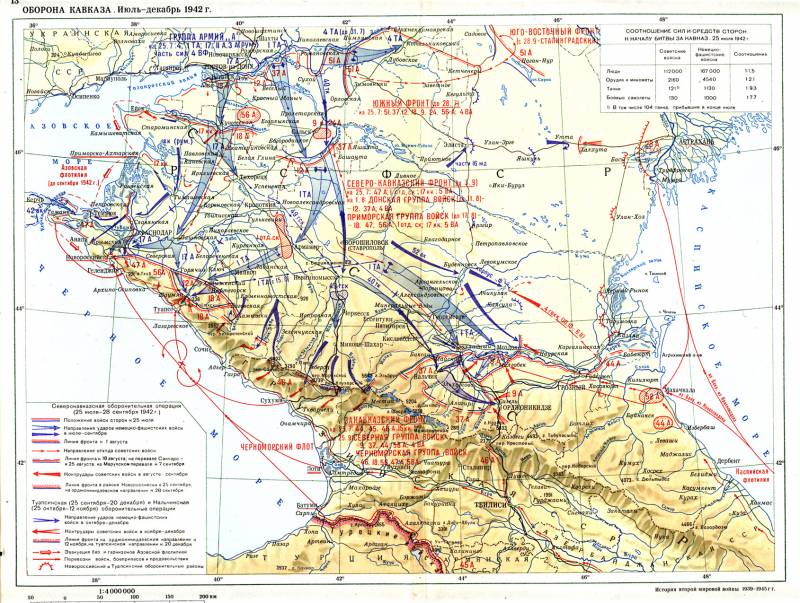
Information